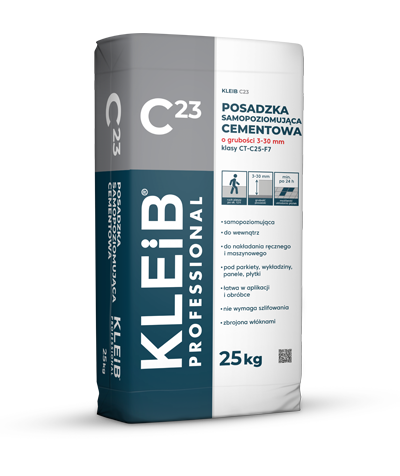SELF-LEVELLING CEMENT SCREED
KLEIB C23 is designed for manual or mechanical execution of thin layer levelling screeds on all kinds of mineral substrates for final finishing cladding, such as tiles, panels, parquets, carpeting etc.
- self-levelling
- for indoor use
- for manual and machine application
- to be used under parquets, carpeting, panels, tiles
- easy to apply and process
- no grinding required
- fibre reinforced

25 kg
54
Approximately 1.5 kg of dry mass per 1 m², with the thickness of 1 mm.
CALCULATE CONSUMPTIONKLEIB C23 is designed for manual or mechanical execution of thin layer levelling screeds on all kinds of mineral substrates for final finishing cladding, such as tiles, panels, parquets, carpeting etc.
The working surface should be well dried, stable and structurally sound i.e. strong enough, free of any layers (such as dust, grease, paints, bituminous substances etc.) that may impair mortar adhesion. Any defects and cracks should be filled with mortars suitable for this type of work, e.g. KLEIB C22. Before pouring the screed, prime the substrate with KLEIB G1 primer or KLEIB G2 primer using a brush. In places where the working surface is cracked and in stress concentration areas, fiberglass mesh reinforcement should be used. Edge expansion joints should always be executed (stick Styrofoam or sponge strips to the walls). If there are expansion joints in the subfloor, they must be repeated in the floor layer. Expansion joints should also be used to separate the area from other structural elements of the building such as columns, walls and stairs, and where its thickness changes.
Mix the contents of the bag mechanically with the specified amount of clean, cold water to obtain a uniform and proper consistency. After waiting 5 minutes, stir again. If the screed is mixed and poured mechanically, the volume of water should correspond to the device used. Observe the correct water dosage. Overdosage will reduce the strength of the floor and increase the setting time, and may cause cracking.
Pour to a fixed level (using e.g. special elevation marks), remove excess air with a spiked roller. In places where expansion joints exist in the subfloor, they should also be made in the poured layer. It is recommended to start work at the wall furthest from the entrance to the room, and proceed with strips approx. 40 cm wide. In case of very wide rooms, it is recommended that smaller work areas (3-6 m wide, depending on the speed of pouring out the mass) are separated. After pouring, the mass should be spread with a steel trowel, and entrapped air released with a spiked roller. Work must be carried out continuously until the entire floor area of the room is covered. Premature drying of the freshly laid mass should be prevented by limiting heating, protection against direct sunlight, draughts and too low air humidity. These conditions must also be maintained during the execution of the work. After min. 3 days (depending on thickness), PVC carpets, panels, carpet and cork flooring can be installed provided that the floor humidity does not exceed 2.5%. Before installing sealed coverings, e.g. PVC and laminate or layered wood floors, structural moisture of the floor and substrate must be tested using the CM method. The screed can be walked on after approx. 12 hours. Bonding of tiles after min. 24 hours (depending on thickness), and full load after approx. 7 days. Full setting and drying time: 28 days. Underfloor heating can be started after min. 7 days.
Approximately 1.5 kg of dry mass per 1 m², with the thickness of 1 mm.
The mortar should be stored in tightly closed bags in dry conditions for up to 12 months from the production date specified on the packaging.
